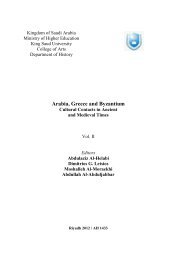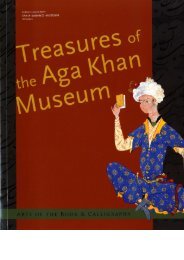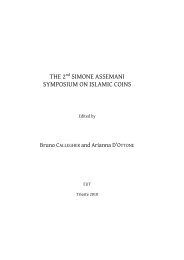ulum-al-quran
ulum-al-quran
ulum-al-quran
You also want an ePaper? Increase the reach of your titles
YUMPU automatically turns print PDFs into web optimized ePapers that Google loves.
CHAPTER 3 : The Qur'an in Manuscript and Print<br />
THE QUR'ANIC SCRIPT<br />
Writing, <strong>al</strong>though not very widespread in pre-Islamic time, was well-known among the Arabs. The script used in the<br />
seventh century, i. e . during the lifetime of the Prophet Muhammad, consisted of very basic symbols, which expressed<br />
only the consonant<strong>al</strong> structure of a word, and even that with much ambiguity.<br />
While today letters such as ba, ta, tha, ya, are easily distinguished by points, this was not so in the early days and <strong>al</strong>l<br />
these letters used to be written simply as a straight line.<br />
From this very basic system of writing there developed over the ages, various types of script, such as Kufi, Maghribi,<br />
Naskh, etc., which spread <strong>al</strong>l over the world.<br />
The later invention of printing with standardised types has contributed to form<strong>al</strong>ising the writing.<br />
However, as far as the actu<strong>al</strong> script of the Qur'an is concerned, there were two important steps which brought about the<br />
forms in which we have the Qur'anic text as it is today. These were the introduction of:<br />
<br />
<br />
Vowelling marks (tashkil).<br />
Diacritic<strong>al</strong> marks (i'jam).<br />
Tashkil<br />
Tashkil is the name for the signs indicating the vowels in Arabic scripts. They were apparently unknown in pre-lslamic<br />
times. These signs help to determine the correct pronunciation of the word and to avoid mistakes.<br />
Example: Byt Baitun<br />
When more and more Muslims of non-Arab origin and <strong>al</strong>so many ignorant Arabs' [Yaqut reports in his book irshad that <strong>al</strong>-<br />
Hajjaj b. Yusuf himself once read ahabba in 9: 24 wrongly as ahabbu, see GdQ. 111, 124, note 6.] studied the Qur'an,<br />
faulty pronunciation and wrong readings began to increase. It is related that at the time of Du'<strong>al</strong>l (d. 69H/638) someone<br />
in Basra read the following aya from the Qur'an in a faulty way, which changed the meaning completely: :<br />
That God and His apostle dissolve obligations with the pagans (9: 3).<br />
That God dissolves obligations with the pagans and the apostle (9: 3).<br />
The mistake occurred through wrongly reading rasulihi in place of rasuluhu, which could not be distinguished from the<br />
written text, because there were no signs or accents indicating the correct pronunciation. Unless someone had<br />
memorized the correct version he could out of ignorance easily commit such a mistake. [See <strong>al</strong>so fihrist, 1, pp. 87-8.] The<br />
signs or accents to prevent such problems were introduced not long before the i'jam and then got the shape they have to<br />
this day: [Hughes,T.P.: A Dictionary of Islam London,1895 p.687.]<br />
For an example of the old style see plate 5.<br />
It has been suggested that the origin of fatha is <strong>al</strong>if, the origin of kasra is ya (without dots as in early books), and the<br />
origin of damma is waw. Hamza was previously written as 2 dots. [Abbott, N.: The Rise of the North-Arabic Script and its<br />
Koranic Development, Chicago, 1939, p. 39]<br />
I'jam (to provide a letter with a diacritic<strong>al</strong> point)<br />
The Arabic letters, as we know them today, are made up of lines and points. The latter are c<strong>al</strong>led i'jam. The ancient<br />
Arabic script did not have them, but consisted of strokes only.<br />
The addition of diacritic<strong>al</strong> points to the plain writing of strokes helped to distinguish the various letters which could be<br />
easily mixed up.<br />
Example: XXX XXX<br />
Without dots this word cannot be easily recognized. With i'jam, the letters of this word can easily be distinguished.





